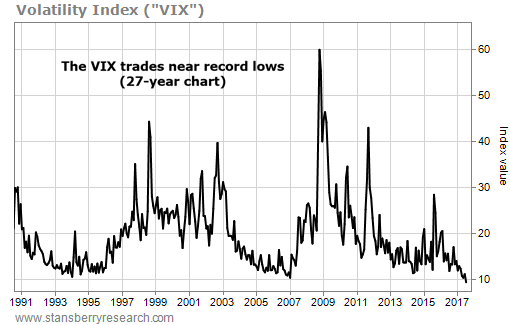Bull markets are wonderful…
You get to watch your stocks rise in value, of course.
But bull markets – especially the current one – come with another major benefit.
Most folks overlook it because they don’t want to buy assets that are underperforming stocks.
And even fewer are ready to buy assets that are likely to lose money as the bull market continues.
And that’s a wonderful thing… because it means “portfolio insurance” is dirt-cheap right now. By some measures, it’s nearly as cheap as ever before.
Today, I’ll explain how it works – and why you should strongly consider it now, while it’s cheap. I’ll also point you to the best place to go for advice on how and what to buy.
This wealth-protection strategy is buying long-dated put options. The idea is simple…
When you buy a put option, you buy the right – but not the obligation – to sell a stock at a fixed price for a set period of time.
For example, you could buy the right to sell shares of tech giant Apple (AAPL) at $100 at any time up until January 2019. (Let’s say buying that right would cost you about $2.20 per share.)
If you own the stock, this puts a “floor” under your shares (at $100) because you have the right to sell the stock at that price. That’s one way these puts can act as a form of insurance… But it’s not the one I’m talking about today.
If you don’t own the stock, buying a put serves as a bet that the stock will fall…
Sticking with the example above, let’s say you believe that Apple will burn through its $257 billion in cash, competition will drive the company into the ground, and it will go bankrupt within the next year and a half.
You ignore the critics and buy the Apple January 2019 $100 puts for $2.20.
To the great surprise of everyone (but you), Apple goes bankrupt and shares drop to $0. The puts you bought for $2.20 per share are now worth $100 per share. A $220 bet turns into $10,000. A $660 bet turns into $30,000. It’s a 4,445% return.
In a bear market, that one small bet goes a long way toward helping you preserve or increase your wealth.
Now… I chose what is probably the least likely company in the world to go bankrupt before January 2019. But other companies are much more likely to meet their end in that time. If you buy puts on a bunch of them and a few work out, you’ll do wonders for your portfolio.
Now that you know how buying long-dated puts works as portfolio insurance, I want to explain why they’re so cheap right now…
It has to do with the Volatility Index (“VIX”). Traders often call it the market’s “fear gauge” because it rises when folks are worried about stock prices dropping, and it falls when they’re not.
The VIX works by measuring prices that people are willing to pay for options.
As we just covered, people buy put options when they’re worried about a crash. Put prices rise with demand… and that makes the VIX rise, too.
But right now, as you can see in the chart below, the VIX is near its lowest level ever. (It hit its second-lowest level in history, 9.36, on Friday.)

We used monthly data rather than daily data for this chart so the line would be clearer. But the VIX dropped below 10 in early 2007, not long before the market topped out. And the VIX peaked at 80.86 in late 2008, just before the market bottomed.
In other words, people are often willing to pay the most for portfolio insurance when they least need it… And they’re often not willing to pay low prices when they need it most.
It doesn’t always work out like that. Sometimes the VIX drops just before stocks make a huge run higher. That’s what happened after the VIX hit its lowest level ever in 1993.
But the fact remains, portfolio insurance is dirt-cheap today. You can ignore it… Or you can dramatically reduce your risk with very little money.
Good trading,
Ben Morris
[ad#stansberry-ps]
Source: Daily Wealth


